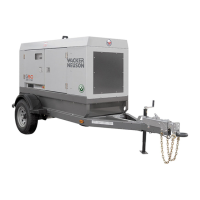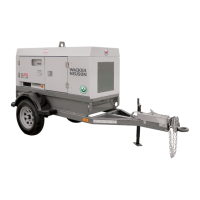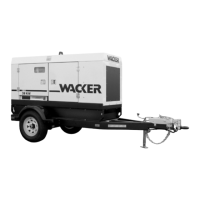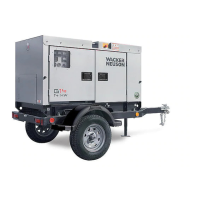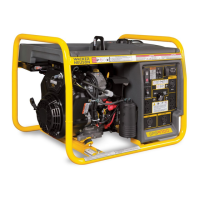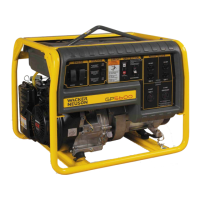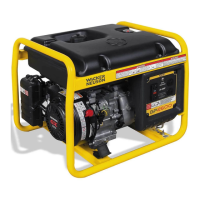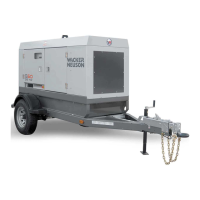
Do you have a question about the Wacker Neuson G50 and is the answer not in the manual?
| Brand | Wacker Neuson |
|---|---|
| Model | G50 |
| Category | Portable Generator |
| Language | English |
Explains the importance of recording model, item, revision, and serial numbers from the nameplates.
Describes the certification label confirming trailer conformity to federal motor vehicle standards.
Instructions on how to report trailer safety defects to NHTSA and WACKER Corporation.
Lists additional operator manuals provided with the generator for convenience.
Explains DANGER, WARNING, CAUTION, and NOTE callouts for safety and damage reduction.
Highlights severe electrical shock hazard present when the generator is running.
Provides crucial safety guidelines for operating the generator, including warnings and precautions.
Warns about the severe injury or death risk to utility workers from generator backfeed.
Details safety procedures for servicing the generator, including electrical component shutdown and grounding.
Emphasizes the necessity of a proper earthen ground for generator safety and compliance.
Lists hazards and safety guidelines related to operating internal combustion engines and fueling.
Provides essential safety checks and procedures for safely towing the generator trailer.
Presents performance, generator, and trailer specifications for G50, G70, and G85 models.
Details engine specifications and provides key physical dimensions of the generator unit.
Explains international pictorial labels used for safety warnings and operational information.
Describes pictorial labels related to lifting points, circuit breakers, and electrical grounding.
Illustrates the placement of various operating and safety labels on the generator unit.
Provides summarized operating instructions in multiple languages for generator start-up and shutdown.
Details wiring connections for the trailer, including brake lights and directional signals.
Identifies and describes the various components of the generator's main control panel.
Details the emergency stop button and the voltage selector switch functions.
Details the LCD display for engine and generator information and fault conditions.
Explains how to monitor generator voltage, amperage, and frequency via the LCD panel.
Details engine monitoring parameters like oil, fuel, temperature, battery, and running hours displayed on the LCD.
Lists and explains the six fault conditions that cause the engine to shut down automatically.
Describes the current overload fault condition and the necessary steps before restarting.
Explains the voltage selector switch, emergency stop button, and main circuit breaker.
Describes the location and function of the main line circuit breaker.
Explains the engine start switch and the voltage adjustment rheostat for output control.
Explains the amber warning light as a pre-alarm for potential engine fault conditions.
Describes the customer connection lugs for attaching outside loads and making connections.
Explains the importance and location of the ground connection for safe operation.
Details receptacles, remote run terminal block, and panel door interlock switch.
Describes the panel door interlock switch and its function on the main circuit breaker.
Provides diagrams and warnings for making terminal connections by a trained electrician.
Presents a checklist of pre-start-up inspections and procedures to ensure safe operation.
Provides detailed step-by-step instructions for manually starting the generator.
Instructs on leaving the start switch in the correct position and warming the engine before loading.
Explains how environmental factors affect engine power output and provides correction data.
Details the procedure for safely shutting down the generator, including load removal and cooling.
Provides guidelines for overnight storage, including securing doors and avoiding wet areas.
Advises following manufacturer recommendations for long-term storage to prevent corrosion.
Explains how to prepare the generator for automatic or remote start-up mode.
Discusses the use of transfer switches for isolation and safe operation with utility systems.
Provides a comprehensive checklist for safely towing the generator trailer.
Introduces engine maintenance and refers to the engine operator's manual for details.
Provides initial operating and maintenance steps for new generator units.
Outlines basic maintenance intervals for the engine and generator based on time or hours.
Instructs on how to reset the periodic maintenance timer after performing service.
Details how to replace the air filter cartridge and check the air cleaner assembly.
Details the step-by-step procedure for replacing the air filter cartridge and checking connections.
Covers engine oil level checks, oil changes, and specific break-in service procedures.
Provides instructions for checking engine coolant levels and warnings about hot coolant.
Details maintenance checks for trailer tires, wheels, hubs, and brakes.
Guides through troubleshooting common automatic engine shutdown conditions.
Presents a wiring diagram for the generator and its receptacles, with a reference list.
Provides the engine wiring diagram with color codes and a reference list for components.
Details the trailer wiring for both electric and standard/hydraulic brake systems.
